Nattam, Kailasanathar Temple
Historical background
Sited in Dindigul district, Tamil Nadu, Nattam (Nattam Kovilpatti) is a small town some 40 km north of Madurai. Its main attraction is the west-facing Shaiva Kailasanathar temple, with its sub-shrine, dedicated to Senbogavalli Amman.
Read more
The core of the Kailasanathar temple is believed to date of the Pandya era, between the 13th and the 14th centuries. During the late 16th and 17th centuries, the Nayakas were responsible for substantially enlarging the temple. Dating of this period and particularly interesting is the pillared hall immediately before the entrance to the second enclosure of the temple. Its six engaged columns are embellished by sculptures, possibly portraits of donors. On its ceiling, is a unique set of iconic and topographic paintings. The central part of the ceiling, consisting of three registers, shows both deities as well as portraits, whereas twenty six views of temples, arranged into four and three registers occupy respectively the north and south portions of the ceiling.
All the temples depicted, but one, the Kashi Vishvanatha, are either in Tamil Nadu or in modern day Andhra Pradesh. The particular form of the deity worshipped at each site is carefully rendered. Typical features of the landscape, such as the hills at Alagar Koyil, Tirupati, Palani and Tirupparankundram or the ocean at Rameswaram are emphasised. Elements which play a pivotal role in the lore of individual temples are clearly rendered e.g. the sacred tree, at both Tiruvanaikkaval and Tiruvidaimarudur. Last but not least, animal and human devotees such as is the case at Srikalahasti, are prominently depicted. All the vignettes are provided with bilingual inscriptions in Telugu and Tamil.
From the surviving inscriptions identifying the portraits, it appears that members of the merchant community were the main patrons of the paintings.
The paintings on the ceiling of the porch of the Senbogavalli Amman shrine depict the events leading to the miraculous the birth of Kumara, and the equally miraculous birth of the goddess Minakshi, the patron goddess of the nearby city of Madurai. Unfortunately, a large portion of the ceiling is in a sad state of disrepair, so it is difficult to make out the subject matter of the paintings.
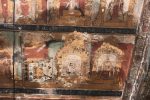
Date: Second half of the 17th century
Description: View of the Kashi Vishvanatha Temple at Varanasi, showing Vishvanatha and his consort. The series of miniature lingas shown on the left may refer to the lingas set in the court of the temple. They represent the ganas who came to Varanasi along with Shiva.
Location: Tamil Nadu Temple;Kailasanathar Temple;Nattam
Positioning: Open mandapa, celiing, north portion
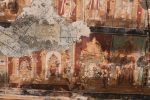
Date: Second half of the 17th century
Description: From left: 1) View of the Arunachaleshvara Temple at Tiruvannamalai, where one of the five elemental lingas of South India, the linga of fire, is worshipped. 2) View of the Kalahastishvara Temple at Srikalahasti, seat of yet another of the five elemental lingas, the Vayu-linga (linga of air). In the foreground are three characters intimately connected with this place: The hunter Kannappa, one of the 63 nayanmars, and the animal devotees, who worshipped the linga: an elephant, a snake, and a spider.The latter has disappeared. On the right is the shrine of the goddess Gnanaprasunambika.
Location: Tamil Nadu Temple;Kailasanathar Temple;Nattam
Positioning: Ceiling of the open mandapa, north section
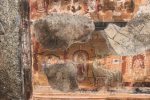
Date: Second half of the 17th century
Description: View of an unidentified Shaiva holy site.
Location: Tamil Nadu Temple;Kailasanathar Temple;Nattam
Positioning: Ceiling of the open mandapa, north section
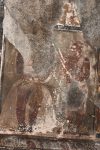
Date: Second half of the 17th century
Description: Nobleman and Shaiva pujari.
Location: Tamil Nadu Temple;Kailasanathar Temple;Nattam
Positioning: Ceiling of the open mandapa, central section
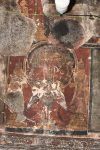
Date: Second half of the 17th century
Description: Arumurugasn (six-headed Murugan) riding on the peacock flanked by his consorts, Valli and Devasena.
Location: Tamil Nadu Temple;Kailasanathar Temple;Nattam
Positioning: Ceiling of the open mandapa, central section
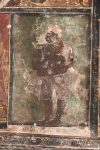
Date: Second half of the 17th century
Description: Portrait of a donor.
Location: Tamil Nadu Temple;Kailasanathar Temple;Nattam
Positioning: Ceiling of the open mandapa, central section
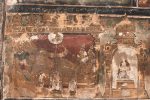
Date: Second half of the 17th century
Description: From left: 1) View of the Sarangapani Temple at Kumbakonam. Vishnu, from whose navel emerges a lotus on which sits Brahma, reclines on the serpent Shesha. In his raised left hand, the deity carries a bow. His consorts sit at this feet. In the foreground are the processional images. 2) Vriddhagirishvara Temple at Vriddhachalam, linga shrine.
Location: Tamil Nadu Temple;Kailasanathar Temple;Nattam
Positioning: Ceiling of the open mandapa, north section
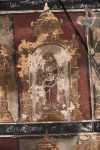
Date: Second half of the 17th century
Description: Vriddhagirishvara Temple, Vriddhachalam, shrine of the goddess Vriddhambikai.
Location: Tamil Nadu Temple;Kailasanathar Temple;Nattam
Positioning: Ceiling of the open mandapa, north section
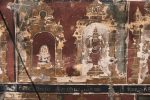
Date: Second half of the 17th century
Description: Tiruvayaru, AyyarappanTemple (aka Panchanadishvara Temple) with the linga and the goddess Aramvalarta Nayaki carrying Vishnu’s attributes, the conch and the discus.
Location: Tamil Nadu Temple;Kailasanathar Temple;Nattam
Positioning: Ceiling of the open mandapa, north section
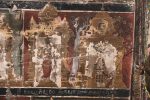
Date: Second half of the 17th century
Description: Tiruvanaikkaval temple (aka Sri Jambukeshvara), on Srirangam Island. At the centre of the tableau is the jambu tree which grew from the body of an ascetic who worshipped Shiva at this place. On the left, is the shrine of Akhilandeshvari. On the right is the Appu linga, the water-linga, one of the five elemental lingas worshipped in South India. Barely visible, on the right is the spider’s web extending from the wall of the shrine to the branch of the jambu tree. Beneath it, an elephant holds a conch in its trunk preparing to worship the linga.
Location: Tamil Nadu Temple;Kailasanathar Temple;Nattam
Positioning: Ceiling of the open mandapa, north section
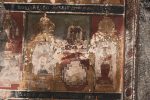
Date: Second half of the 17th century
Description: View of the Adi Kumbeshvara Temple at Kumbakonam. A large Ganesha is shown immediately above the tank in between the shrine of Adi Kumbeshvara and that of his consort, Mangalambikai.
Location: Tamil Nadu Temple;Kailasanathar Temple;Nattam
Positioning: Ceiling of the open mandapa, north section
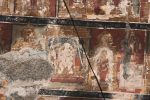
Date: Second half of the 17th century
Description: Tyagarajaswamy Temple, Tiruvarur. The image of Valmikinatha in the main shrine has disappeared. However, the Kamalambikai shrine and the large lotus tank have survived. In the background is the temple chariot.
Location: Tamil Nadu Temple;Kailasanathar Temple;Nattam
Positioning: Ceiling of the open mandapa, north section
« Previous 1 2 3 4 5 … 7 Next »